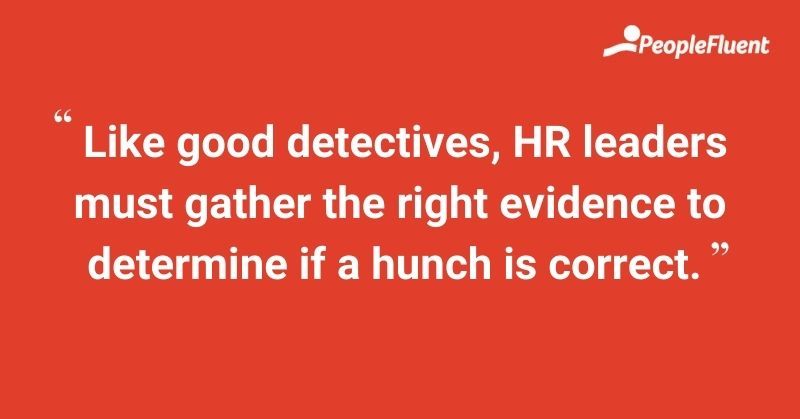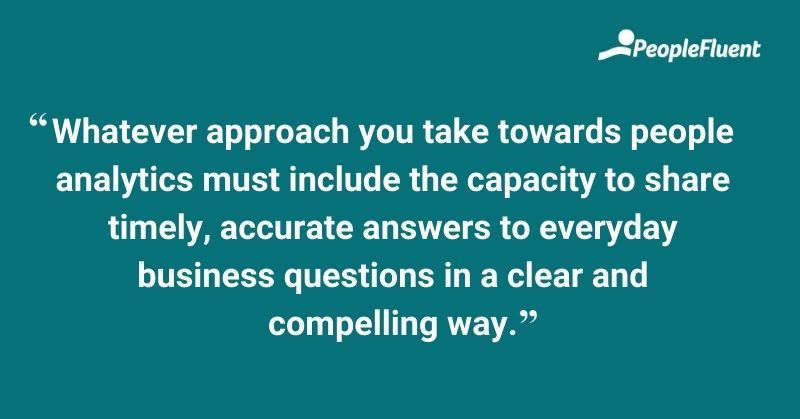Published: Sep 15, 2021Time to read: 5mins Category: Insights
3 Actionable Steps to Shape Your People Analytics Strategy
As people analytics becomes more important to business, so too does the need to understand your data. That’s why you need an actionable strategy to improve and shape your HR data to better inform the decisions you make. Here are three easily actionable steps to help you get started.
People analytics has become an essential HR capability. The demand from senior leaders for timely and effective answers to core workforce and strategic business questions is continually increasing.
However, dispute its complexity, the analytical skills required to thrive in today’s digital environment are within your reach. Bring your curiosity and people savvy—and let the technology do the rest. With just a few steps, you can have a proven and repeatable process for delivering the answers, enabling you and your leaders to make the right people decisions at the right time.
Here are three actionable steps you can take to support your people analytics.
RELATED READING | ‘Want to Focus Your People Analytics Strategy? Start With the End in Mind’

1. Gather Evidence
Like good detectives, HR leaders must gather the right evidence to determine if a hunch is correct. The HR team at a leading German science and technology company in healthcare, life science, and performance materials challenged the idea that there’s an ideal span of control number.
There have been many studies on the span of control, most of the time stating that the global benchmark is 8-10 reports per manager. However, by analyzing its data, the team learned that one of its departments performed higher having a smaller team size than the global benchmark.
For many HR leaders, gathering evidence to perform an analysis is a struggle since people data is typically:
- Located in multiple systems and formats
- Incomplete and constantly changing
- Inconsistent and of poor quality
- In need of transformations and restructuring
In the past, the response was to build a data warehouse, which allows for a single view across different data sources and ensures every piece of data has a place. However, maintaining a data warehouse—one that can grow and expand as your data increases and analytics needs change— is notorious for being time-consuming, complex, and costly.
The best alternative to data warehousing is to invest in a people analytics platform that brings data together from all your systems and—even better—comes with pre-built content that makes it simple to interpret the data, no matter your analytical or quantitative expertise.
This kind of data accessibility gives you the ability to quickly spot relationships and patterns out of mountains of data, leading you to the evidence needed to decide on and shift strategies in an agile manner.
YOU MIGHT ALSO LIKE | ‘Rapid Pace of Change: 3 Ways HR Teams Can Prioritize Data Security’

2. Answer the Questions
Once your data is in place, it’s time to start answering your workforce questions. But depending on the solution you’ve selected, this might be easier said than done. To find the data that’s most relevant to your business objectives, you need to go deeper into the evidence that you’ve gathered.
If your goal is to reduce overtime costs, for example, looking only at turnover rate will tell you how many people left, but not why. You need to consult and interrogate your data to ensure that the answers you find are much more relevant to the question at hand—and the decisions your business needs to make.
Using the example above, leverage analytics to find answers to questions like:
- Why are you overspending on your overtime budget?
- Did you lose a key employee or department, and is the overtime to compensate for this?
- Are your total rewards not aligned with the actual needs and wants of your employees?
People analytics enables you to go beyond typical HR questions to better understand the “why” driving issues, as well as opportunities.
The speed at which you can surface answers to these questions is also critical. You need the ability to surface and interpret the data yourself without relying on a data science degree or data scientists who may have competing priorities that can delay your project.
3. Share the Answers
Whatever approach you take towards people analytics must include the capacity to share timely, accurate answers to everyday business questions—in a clear and compelling way.
This is an important consideration, particularly when decision-makers are distributed across multiple locations. Sharing data can help you elevate your role in the business.
Here are some leading practices to sharing data:
- Leverage dashboards to provide an at-a-glance view of key performance indicators to business leaders.
- Select an analytics solution that will allow end-users to interact with dashboards by applying different filters to the data, such as highlighting specific roles, high performers, or new hires. This supports better insights and decision-making.
- People’s brains are wired to quickly recognize the patterns and trends in visual answers. Rather than sharing rows of data points, look to leverage interactive visualizations in your dashboards and slideshows.
- Use the right data visualization. The wrong visual representation of data can be as damaging or misleading as sharing incorrect data. Best-in-class people analytics solutions will associate the correct visuals with the relevant analytics for you, mitigating this risk.
HANDPICKED FOR YOU | ‘4 Key Components of Building a Data-Driven DEI Strategy’

Dive Into Your People Data!
This article has been adapted from our ebook ‘5 Steps to Getting Started With People Analytics’. You’ve read about three of the five steps—for more, download your copy to find out how to use the data to take action.